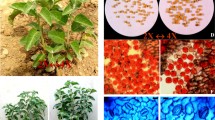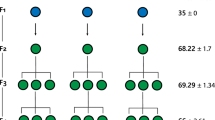Abstract
Sexuality is correlated with diploidy and apomixis with polyploidy in the Brachiaria genus. Brachiaria ruziziensis is a key species in Brachiaria breeding due to its obligate sexuality and intrinsic agronomic qualities. Interspecific crosses in the genus became feasible only when a few diploid accessions of B. ruziziensis were artificially tetraploidized and remained sexual. Hybridization has been done since, using natural tetraploid apomictic accessions of B. brizantha or B. decumbens as pollen donors. Twenty two accessions of B. ruziziensis from the Embrapa Beef Cattle germplasm collection (Campo Grande, MS, Brazil) were cytologically analyzed: 16 are natural diploids (2n = 2x = 18) and six are artificially induced tetraploids (2n = 4x = 36). The meiotic behavior in the 16 diploid accessions varied. The mean of meiotic abnormalities per accession ranged from zero to 24.46%. Meiotic behavior in the induced tetraploid accessions also varied with the mean of meiotic abnormalities ranging from 5.20% to 54.71%. The most common abnormalities observed in both the diploid and the tetraploid accessions, were those related to irregular chromosome segregation. In one tetraploid accession, with a high frequency of those, other irregularities involving chromosome orientation at metaphase plate and chromosome convergence to the poles, a meiotic mutation known as divergent spindle, were recorded. Meiotic behavior should be considered in selecting potential genitors for breeding.


Similar content being viewed by others
References
Clark FJ (1940) Cytogenetic studies of divergent meiotic spindle formation in Zea mays. Am J Bot 27:547–559
Ferguson JE, Crowder LV (1974) Cytology and breeding behaviour of Brachiaria ruziziensis. Crop Sci 14:893–895
Fuzinatto VA, Pagliarini MS, Valle CB (2007) Evaluation of microsporogenesis in sexual Brachiaria hybrids (Poaceae). Genet Mol Biol 6:1107–1117
Gobbe J, Swenne A, Louant BP (1981) Diploïdes naturels et autotétraploïdes induits chez Brachiaria ruziziensis Germain et Evrard: critères d’identification. Agron Trop 36:339–346
Keller-Grein G, Maass BL, Hanson J (1996) Natural variation in Brachiaria and existing germoplasma collections. In: Miles JW, Maass BL, Valle CB (eds) Brachiaria: biology, agronomy, and improvement. CIAT/Embrapa, Colombia, pp 17–42
Mendes-Bonato AB, Pagliarini MS, Valle CB, Penteado MIO (2001) A severe case of chromosome stickiness in pollen mother cells of Brachiaria brizantha (Hochst) Stapf (Gramineae). Cytologia 6:287–291
Mendes-Bonato AB, Pagliarini MS, Forli F, Valle CB, Penteado MIO (2002a) Chromosome number and microsporogenesis in Brachiaria brizantha (Gramineae). Euphytica 125:419–425
Mendes-Bonato AB, Junqueira Filho RG, Pagliarini MS, Valle CB, Penteado MIO (2002b) Unusual cytological patterns of microsporogenesis in Brachiaria decumbens: abnormalities in spindle and defective cytokinesis causing precocious cellularization. Cell Biol Int 26:641–646
Mendes-Bonato AB, Pagliarini MS, Risso-Pascotto C, Valle C (2006a) Chromosome number and meiotic behavior in Brachiaria jubata (Gramineae). J Genet 85:83–87
Mendes-Bonato AB, Pagliarini MS, Valle CB (2006b) Abnormal spindle orientation during microsporogenesis in an interspecific Brachiaria (Gramineae) hybrid. Genet Mol Biol 29:122–125
Mendes-Bonato AB, Risso-Pascotto C, Pagliarini MS, Valle CB (2006c) Cytogenetic evidence for genome elimination during microsporogenesis in an interspecific hybrid between Brachiaria ruziziensis and B. brizantha (Poaceae). Genet Mol Biol 29:711–714
Miles JW, Valle CB, Rao IM, Euclides VPB (2004) Brachiariagrasses. In: Sollenberger L (ed) Warm-Season (C4) Grasses. ASA, CSSA, SSSA, Madison. pp 745–760
Ndikumana J (1985) Etude de I’hybridation entre espèces apomictiques et sexuées dans le genre Brachiaria, PhD Thesis. Université Catholique de Louvain, Belgium, 210 p
Penteado MIO, Santos ACM, Rodrigues IF, Valle CB, Seixas MAC, Esteves A (2000) Determinação de poliploidia e avaliação da quantidade de DNA total em diferentes espécies de Brachiaria. Boletim de Pesquisa No. 11. Campo Grande-MS, Embrapa Gado de Corte, 19 p
Pinheiro AA, Pozzobon MT, Valle CB, Penteado MIO, Carneiro VTC (2000) Duplication of the chromosome number of diploid Brachiaria brizantha plants using colchicine. Plant Cell Rep 19:274–278
Risso-Pascotto C, Pagliarini MS, Valle CB, Mendes-Bonato AB (2003a) Chromosome number and microsporogenesis in pentaploid accession of Brachiaria brizantha (Gramineae). Plant Breed 122:136–140
Risso-Pascotto C, Pagliarini MS, Valle CB (2003b) A mutation in the spindle checkpoint arresting meiosis II in Brachiaria ruziziensis. Genome 46:724–728
Risso-Pascotto C, Pagliarini MS, Valle CB, Jank L (2004) Asynchronous meiotic rhythm as the cause of selective chromosome elimination in an interspecific Brachiaria hybrid. Plant Cell Rep 22:945–950
Risso-Pascotto C, Pagliarini MS, Valle CB (2005a) Multiple spindles and cellularization during microsporogenesis in an artificially induced tetraploid accession of Brachiaria ruziziensis (Gramineae). Plant Cell Rep 23:522–527
Risso-Pascotto C, Pagliarini MS, Valle CB (2005b) Meiotic behavior in interspecific hybrids between Brachiaria ruziziensis and Brachiaria brizantha (Poaceae). Euphytica 145:155–159
Risso-Pascotto, Pagliarini MS, Valle CB (2006) Microsporogenesis in Brachiaria dictyoneura (Fig. & De Not.) Stapf (Poaceae: Paniceae). Genet Mol Res 5:837–845
Schank SC, Sotomayor-Ríos A (1968) Cytological studies on Brachiaria species. Soil Crop Sci Soc Fla Proc 28:156–162
Shamina N, Dorogova N, Trunova S (2000) Radial spindle and the phenotype of the maize meiotic mutant, dv. Cell Biol Int 24:729–736
Staiger CJ, Cande WZ (1990) Microtubule distribution in dv, a maize meiotic mutant defective in the prophase to metaphase transition. Dev Biol 138:231–242
Swenne A, Louant BP, Dujardin M (1981) Induction par la colchicine de formes autotétraploïdes chez Brachiaria ruziziensis Germain et Evrard (Gramínée). Agron Trop 36:134–141
Utsunomiya KS, Pagliarini MS, Valle CB (2005) Microsporogenesis in tetraploid accessions of Brachiaria nigropedata (Ficalho & Hiern) Stapf (Gramineae). Biocell 29:295–301
Valle CB (1986) Cytology, mode of reproduction, and forage quality of selected species of Brachiaria Griseb, PhD Thesis. University of Illinois, Illinois, 89 p
Valle CB, Savidan YH (1996) Genetics, cytogenetics, and reproductive biology of Brachiaria. In: Miles JW, Maass BL, Valle CB (eds) Brachiaria: biology, agronomy, and improvement. CIAT/Embrapa, Colombia, pp 147–163
Valle CB, Miles JM (2001) Breeding apomictic species. In: Savidan Y, Carman JG, Dresselhaus T (eds) The flowering of apomixis: from mechanisms to genetic engineering. CYMMYT, IRD, European Commission DG (FAIR), Mexico, pp 137–152
Valle CB, Singh R, Miller DA (1987) Pachytene chromosomes of Brachiaria ruziziensis Germain et Evrard. Plant Breed 78:75–78
Acknowledgments
Authors are grateful to the Associação para o Fomento à Pesquisa de Melhoramento de Forrageiras Tropicais (UNIPASTO) for financial support.
Author information
Authors and Affiliations
Corresponding author
Rights and permissions
About this article
Cite this article
Pagliarini, M.S., Risso-Pascotto, C., de Souza-Kaneshima, A.M. et al. Analysis of meiotic behavior in selecting potential genitors among diploid and artificially induced tetraploid accessions of Brachiaria ruziziensis (Poaceae). Euphytica 164, 181–187 (2008). https://doi.org/10.1007/s10681-008-9697-2
Received:
Accepted:
Published:
Issue Date:
DOI: https://doi.org/10.1007/s10681-008-9697-2




